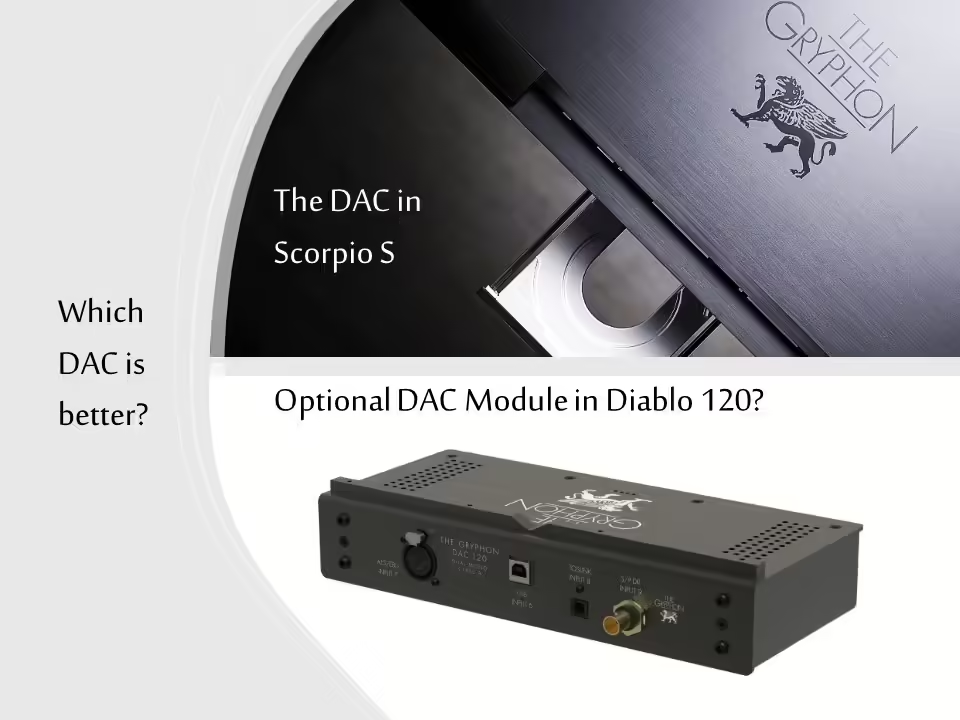FAQs
Gryphon Audio built-in DAC in Scorpio S vs optional DAC module for Diablo 120
With the plethora of both standalone and built-in DAC’s into different electronics, we get asked the question of which “DAC is better” a lot. We also observed many discussions about how one could use a DAC to double up as a digital preamplifier to drive their amps, a topic we do have lots to say about but not for this writing.
One of our clients owns both a Gryphon Scorpio S and a Diablo 120. He was wondering whether the DAC in the Scorpio S is superior to the optional DAC module for the Diablo 120.
From a spec standpoint, the chip used in the DAC for the Diablo 120 is a better chip than the AKM used in the Scorpio S and we believe apples-to-apples, the former should perform better. However, we encourage listeners to try it on their own. Also, it depends on the cables and interconnects you are using.
Here’s what you do with your (a) and (b) test.
(a) Run the Scorpio S directly into the Diablo 120 from the XLR analog output.
(b) Run a digital 75 Ohm cable from the Scorpio S directly into the DAC module
Share your experience with us here!
Below are the individual specs for the two DACs:
| Diablo 120 DAC |
| True Dual Mono Class A Analogue topology |
| Zero negative feedback |
| Sabre ES9018 High-End D/A converter |
| USB input compatible with following audio formats via PC/MAC/Linux: PCM: 44.1, 48, 88.2, 96, 176.4, 192, 352.8 and 384 kHz, up to 32 bits DSD via USB: DSD64 (2.822MHz, 3.072MHz), DSD128 (5.644MHz, 6.144MHz), DSD256* (11.2896MHz) and DSD512* (22.5792MHz) |
| XLR, BNC inputs compatible with PCM: 22.05, 24, 32, 44.1, 48, 64, 88.2, 96, 176.4 and 192 kHz, up to 32 bits |
| TOSLink input compatible with PCM: 22.05, 24, 32, 44.1, 48, 64, 88.2 and 96kHz |
| User-selectable PCM and DSD digital roll-off filters |
| Temperature-compensated, ultra-low jitter crystal oscillator with better than 5 parts per million accuracy |
| Super-Capacitor (12.5 Farad!) power supply for USB module – acts like a true battery supply |
| First-order PCM analogue filters and second-order DSD analogue filters with Polypropylene capacitors |
| Analogue output stages with discrete, ultra-low noise +/- 15VDC regulated voltage supplies for excellent analogue THD and noise suppression |
| Multiple Local Voltage regulators for best digital noise suppression |
| Discrete, separate left/right channel ultra-low noise power supply for analogue section of ES9018 DAC |
| Ultra-short signal path |
| Minimal internal wiring |
| One four-layer printed circuit boards with 70µm copper |
| PCB-mounted sockets eliminate wiring and shorten signal path |
| Gold-plated Swiss Neutric XLR socket for one balanced 110 Ohm AES/EBU source |
| Gold-plated 75 Ohm BNC sockets with Teflon insulation for one S/PDIF source |
| One TOSLink optical input |
| Designed and built in Denmark |
| Scorpio S DAC |
| Four Dual-Differential 32-bit/192 kHz AKM asynchronous digital-to-analogue converters with separate regulated power supplies |
| Upsampling to 32-bit/192 kHz for enhanced sonic performance |
| Gentle digital filter roll-off for ultra-pure high frequencies |
| Two custom-built, temperature-compensated crystal oscillators with better than 5 parts per million accuracy |
| European transport with front loading metal tray |
| True class A, fully discrete analogue circuits with no negative feedback |
| First-order analogue filter with silvered Mica capacitor |
| +/- 20 VDC regulated voltage supplies for best THD and noise suppression in analogue sections |
| Separate custom-built Noratel toroidal transformers for digital and analogue sections |
| 15,000 microFarad power capacitor banks per channel |
| Ultra-short signal path with minimal Internal wiring |
| Balanced analogue outputs with PCB-mounted gold-plated Swiss Neutrik XLR sockets |
| 75 Ohm BNC S/PDIF digital output |
| 4-line, 20 character display with user-selectable illumination (High/Medium/Low/Off) |
| Remote control (also for basic Atilla integrated amplifier functions) |
| 4 x 32bit/192kHz D/A-Converters from AKM |
| Dual differential topology |
| Up-sampling to fs = 192kHz |
| Dual Mono |
| Discrete build class A analog stages |
| Output Level, balanced: 4Vrms |
| Power Supply capacity: 40.000uF |

